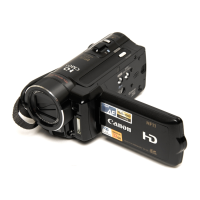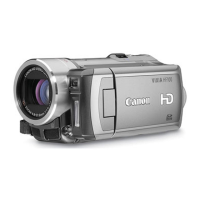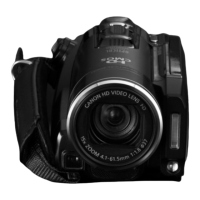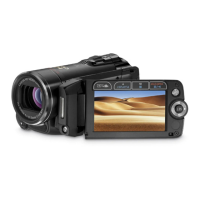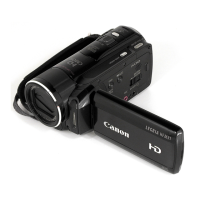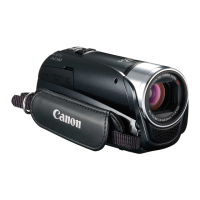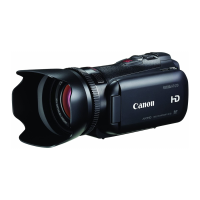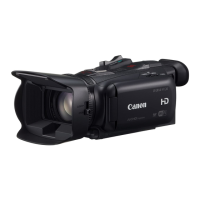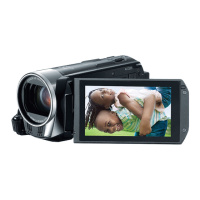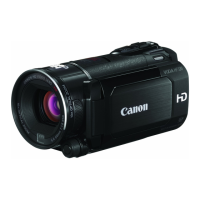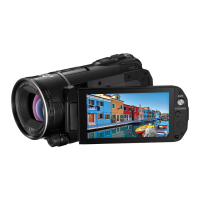Do you have a question about the Canon VIXIA HF10 and is the answer not in the manual?
Product warnings regarding moisture, shock, and interference.
Copyright warning and caution to refer servicing to qualified personnel.
Guidelines on reading, retaining, and following all instructions and warnings.
Safety advice on cleaning, accessories, magnetic fields, water, and placement.
Instructions on safe power source usage and outdoor antenna grounding.
Details on the manual's purpose and how to use it.
Explanation of icons, terms, and abbreviations used in the manual.
Power adapter, battery pack, cables, and software included.
Wireless controller, wrist strap, and software disks provided.
Identification of parts on the camcorder's left side view.
Identification of parts on the camcorder's right side view.
Identification of parts on the camcorder's front view.
Identification of parts on the camcorder's back view.
Identification of parts on the camcorder's top and LCD panel.
Explanation of icons and information shown during movie recording.
Explanation of icons and information shown during movie playback.
Instructions for charging and removing the battery pack.
Using EASY mode and switching between operating modes.
Guidelines for selecting compatible SD/SDHC memory cards.
Steps for starting and stopping video recording.
Choosing recording modes (FXP, XP+, SP, LP) for quality and time.
Using the zoom lever and the quick start feature.
How to review and delete the most recently recorded scene.
Steps for playing back recorded video and selecting scenes.
Using modes like slow playback, frame-by-frame, and scene skipping.
Searching and selecting scenes based on recording date.
Selecting a specific point to start playback using the timeline.
Removing unwanted scenes from memory to free space.
Achieving a cinematic look with Cine Mode and frame rate settings.
Using preset scene programs for various shooting conditions.
Manually adjusting shutter speed and aperture for exposure control.
Turning on and using the camcorder's built-in mini video light.
Using the self timer and automatic backlight correction features.
Manually setting exposure and focus for optimal image quality.
Setting infinity focus and adjusting white balance for accurate colors.
Applying image effects and digital effects for creative video.
Configuring on-screen displays and adjusting audio recording levels.
Connecting and using headphones and external microphones.
Creating, deleting, moving, and copying scenes in playlists.
Steps for capturing still images with the camcorder.
Choosing image size and quality settings for photos.
Deleting unwanted still images from memory.
Navigating and viewing still images using the index screen.
Zooming in on still images for detailed viewing.
Protecting images from erasure and copying them to memory cards.
Direct printing with PictBridge and connecting to a printer.
Configuring print options like paper size, layout, and copies.
Adjusting image trim and setting print orders for multiple photos.
Resolving common errors encountered during photo printing.
Overview of available connection ports on the camcorder.
Diagrams for connecting to TVs via HDMI, component, and USB.
Steps for connecting and playing back recordings on a TV using HDMI.
Methods for backing up movies to a computer using software.
Overview of ImageMixer 3 SE software for managing videos.
Options for saving recordings using DVD burners or external devices.
Creating discs from movies and photos using a DVD burner.
Steps for installing software and connecting the camcorder to a PC.
Troubleshooting steps for power supply, battery, and basic recording/playback.
Troubleshooting issues like recording failure, focus problems, and playback errors.
Interpreting indicator lights and troubleshooting display issues.
Troubleshooting memory card errors, wireless controller, and connections.
Understanding and resolving various error messages from the camcorder and software.
Guidelines for safe handling, temperature, fields, and lens care.
Guidelines for handling, storing, and protecting memory cards.
Warnings and precautions for handling the button cell battery.
Instructions for cleaning the camcorder body, lens, and LCD screen.
Precautions regarding condensation and power supply compatibility.
Information on NTSC system compatibility for TV playback abroad.
Details on compatible battery models and the CG-800 charger.
Information on wide-converters, filters, and HDMI cables.
List of product codes for included and optional accessories.
Specifications for recording system, media, and time.
Technical details on image sensor, LCD screen, and lens configuration.
Specifications for autofocus system and white balance options.
Details on AV OUT, USB, COMPONENT, and HDMI terminals.
Information on power supply, consumption, and operating temperature.
Specifications for the CA-570 Compact Power Adapter.
Details of the limited warranty for Canon equipment in the USA.
Conditions not covered by warranty and how to obtain service.
Instructions for installing ZoomBrowser EX and CameraWindow software.
Instructions for installing ImageBrowser software for Mac OS X.
Step-by-step guide for installing digital video software.
Steps to verify connection, insert disk, and install software.
Entering serial number, certification code, and connecting the camcorder.
Details of the limited warranty for Canon equipment in the USA.
Conditions not covered by warranty and how to obtain service.
Product warnings regarding moisture, shock, and interference.
Copyright warning and caution to refer servicing to qualified personnel.
Guidelines on reading, retaining, and following all instructions and warnings.
Safety advice on cleaning, accessories, magnetic fields, water, and placement.
Instructions on safe power source usage and outdoor antenna grounding.
Details on the manual's purpose and how to use it.
Explanation of icons, terms, and abbreviations used in the manual.
Power adapter, battery pack, cables, and software included.
Wireless controller, wrist strap, and software disks provided.
Identification of parts on the camcorder's left side view.
Identification of parts on the camcorder's right side view.
Identification of parts on the camcorder's front view.
Identification of parts on the camcorder's back view.
Identification of parts on the camcorder's top and LCD panel.
Explanation of icons and information shown during movie recording.
Explanation of icons and information shown during movie playback.
Instructions for charging and removing the battery pack.
Using EASY mode and switching between operating modes.
Guidelines for selecting compatible SD/SDHC memory cards.
Steps for starting and stopping video recording.
Choosing recording modes (FXP, XP+, SP, LP) for quality and time.
Using the zoom lever and the quick start feature.
How to review and delete the most recently recorded scene.
Steps for playing back recorded video and selecting scenes.
Using modes like slow playback, frame-by-frame, and scene skipping.
Searching and selecting scenes based on recording date.
Selecting a specific point to start playback using the timeline.
Removing unwanted scenes from memory to free space.
Achieving a cinematic look with Cine Mode and frame rate settings.
Using preset scene programs for various shooting conditions.
Manually adjusting shutter speed and aperture for exposure control.
Turning on and using the camcorder's built-in mini video light.
Using the self timer and automatic backlight correction features.
Manually setting exposure and focus for optimal image quality.
Setting infinity focus and adjusting white balance for accurate colors.
Applying image effects and digital effects for creative video.
Configuring on-screen displays and adjusting audio recording levels.
Connecting and using headphones and external microphones.
Creating, deleting, moving, and copying scenes in playlists.
Steps for capturing still images with the camcorder.
Choosing image size and quality settings for photos.
Deleting unwanted still images from memory.
Navigating and viewing still images using the index screen.
Zooming in on still images for detailed viewing.
Protecting images from erasure and copying them to memory cards.
Direct printing with PictBridge and connecting to a printer.
Configuring print options like paper size, layout, and copies.
Adjusting image trim and setting print orders for multiple photos.
Resolving common errors encountered during photo printing.
Overview of available connection ports on the camcorder.
Diagrams for connecting to TVs via HDMI, component, and USB.
Steps for connecting and playing back recordings on a TV using HDMI.
Methods for backing up movies to a computer using software.
Overview of ImageMixer 3 SE software for managing videos.
Options for saving recordings using DVD burners or external devices.
Creating discs from movies and photos using a DVD burner.
Steps for installing software and connecting the camcorder to a PC.
Troubleshooting steps for power supply, battery, and basic recording/playback.
Troubleshooting issues like recording failure, focus problems, and playback errors.
Interpreting indicator lights and troubleshooting display issues.
Troubleshooting memory card errors, wireless controller, and connections.
Understanding and resolving various error messages from the camcorder and software.
Guidelines for safe handling, temperature, fields, and lens care.
Guidelines for handling, storing, and protecting memory cards.
Warnings and precautions for handling the button cell battery.
Instructions for cleaning the camcorder body, lens, and LCD screen.
Precautions regarding condensation and power supply compatibility.
Information on NTSC system compatibility for TV playback abroad.
Details on compatible battery models and the CG-800 charger.
Information on wide-converters, filters, and HDMI cables.
List of product codes for included and optional accessories.
Specifications for recording system, media, and time.
Technical details on image sensor, LCD screen, and lens configuration.
Specifications for autofocus system and white balance options.
Details on AV OUT, USB, COMPONENT, and HDMI terminals.
Information on power supply, consumption, and operating temperature.
Specifications for the CA-570 Compact Power Adapter.
Details of the limited warranty for Canon equipment in the USA.
Conditions not covered by warranty and how to obtain service.
Instructions for installing ZoomBrowser EX and CameraWindow software.
Instructions for installing ImageBrowser software for Mac OS X.
Step-by-step guide for installing digital video software.
Steps to verify connection, insert disk, and install software.
Entering serial number, certification code, and connecting the camcorder.
Details of the limited warranty for Canon equipment in the USA.
Conditions not covered by warranty and how to obtain service.
| Image Sensor | CMOS |
|---|---|
| Sensor Size | 1/2.7-inch |
| Effective Pixels | 3.3 Megapixels |
| Optical Zoom | 12x |
| Digital Zoom | 200x |
| LCD Screen Size | 2.7 inches |
| LCD Screen Resolution | 211, 000 pixels |
| Internal Memory | 16 GB |
| Memory Card Slot | SD/SDHC |
| Image Stabilization | Optical |
| Microphone | Stereo |
| Video Resolution | 1920 x 1080 |
| Maximum Aperture | f/1.8 - f/3.0 |
| Sensor Type | CMOS |
| Recording Format | AVCHD |
| Video Format | AVCHD |
